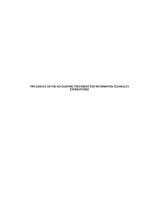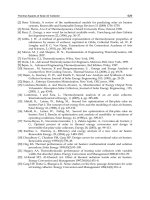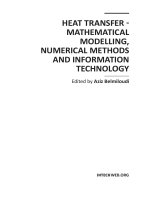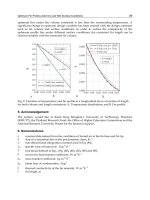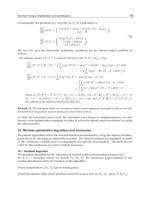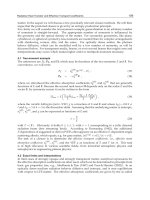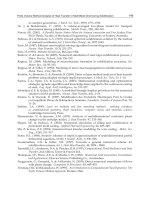Curriculum English for Information Technology: Part 1
Bạn đang xem bản rút gọn của tài liệu. Xem và tải ngay bản đầy đủ của tài liệu tại đây (1.01 MB, 43 trang )
Thai Nguyen University
Faculty of Information Technology
English for
Information Technology
Thai Nguyen, 2012
1
Acknowledgement
We are grateful to the authors, publishers and others who have given the
useful materials to help us complete this book. Our special thanks go to M.A Vu
Duc Thai and colleagues at the Faculty of Information Technology – Thai Nguyen
University for their helpful suggestion and friendly encouragement.
For better preparation and design of English language materials, suggestions
from colleagues and those concerned will be highly appreciated.
2
Course description
English for Information Technology is a topic-based course. To prepare students
for their future job, the course is designed to introduce students to a full range of IT
texts and to give students opportunities to practice their language skills in different
IT contexts. The materials used in this book are arranged from general to more
specialist content so that they can be understood by students easily.
1. Objective
English for Information Technology is designed to:
Provide students with vocabulary related to different major topics in the field of
Computing Information Technology.
Introduce students to some basic knowledge in several areas of Computing and
Information Technology.
Provide students with opportunities to practice and develop their language skills
in general as well as Information Technology contexts.
Develop students’ language skills in the context of computing and information
technology with emphasis on reading, listening, speaking, and writing.
“It is user-friendly to both teachers and students and its clear layout, using both
photos and graphics, will make it a very popular choice for those wishing to
acquire what are now regarded by many to be mandatory skills for employees in
almost every part of the workforce” – Tesol Newsletter.
3
Table of Contents
Pages
Acknowledgment.......................................................................................................... 2
Course description.............................................................................. ........................ 3
Table of contents........................................................................................................ 4
Introduction. ............................................................................................... 5
Lesson 1: Computer applications............................................................................... 6
Lesson 2: Configuration .............................................................................................. 12
Lesson 3: Inside the system ....................................................................................... 17
Lesson 4: keyboard and mouse................................................................................. 24
Lesson 5: Floppy disk and Hard drives .................................................................. 30
Review 1........................................................................................................................... 34
Lesson 6: Spreadsheets and databases................................................................... 39
Lesson 7: Graphics and multimedia ......................................................................... 44
Lesson 8: Faces of the Internet................................................................................. 51
Lesson 9: Programming ................................................................................................ 58
Lesson 10: Future trends............................................................................................ .63
Review 2........................................................................................................................... 68
Further reading........................................................................................................... 71
Glossary .........................................................................................................................83
Reference
4
Introduction
A. How much do you know about the computer and computer related words? You can test your
computer knowledge by putting these words and terms into the appropriate categories. Do not
worry if you cannot do this well now.
Laptop
Minicomputer
Laser printer
Hard disk drive
Motherboard
Monitor
Speaker
Bridge
Memory chips
Joystick
LAN
Expansion card
Scanner
Software engineer/ designer
Hardware engineer
Tracker ball
Keyboard
Software
Barcode reader
Processor
Cache memory
Printer
Fixed hard disk
Clients
Mainframe
Hub
Ring
System analyst
peripherals
Computer salesperson
Floppy disk
Star
Network support person
register
Mouse
Notebook
Types of computers: ..........................................................................................................
Input devices: ......................................................................................................................
Output devices: ..................................................................................................................
Storage devices: ..................................................................................................................
Internet: ..............................................................................................................................
Other components of a computer: .....................................................................................
Job: ....................................................................................................................................
B. Make a list of other Information Technology (IT) words you know in English. Then compare
lists with a partner.
5
LESSON 1: COMPUTER APPLICATIONS
I. Warm-up
Put these letters in the correct order to make a noun phrase that has meaning.
Nioniftoarm yetgoconhl.
Then, use one of the letters in a word “Nioniftoarm” to make other words. Each letter is
used only one time.
II. Reading
A. Match the places in column A with the computer uses in column B.
A
B
1. University
a. Look after patient records and medicines.
2. Library
b. Look after the customers’ money.
3. Bank
c. Scan the price of the goods.
4. Supermarket
d. Catalogue the books and record the books
5. Hospital
that readers borrow.
e. Keep mark and records of the students.
B. Computers have many applications in a great variety of fields. Look at these
photographs of different situations and match them with texts 1 to 4 below.
a
c
d
6
1. Computers can help students perform mathematical operations and solve difficult questions.
They can be used to teach courses such as computer-aided design, language learning,
programming, mathematics, etc.
PCs (personal computers) are also used for administrative purposes: for example, schools use
databases and word processors to keep records of students, teachers, and materials.
2. Race organizers and journalists rely on computers to provide them with the current positions of
riders, and teams in both the particular stages of the race, and in the overall competition.
Workstations in the race buses provide the timing system, and give up-to-the-minute timing
information to TV stations. In the press room, several PCs give real-time information on the state
of the race. Computer databases are also used in the drug- detecting tests for competitors.
3. Computers store information about the amount of money held by each client, and enable staff
to access large databases, and to carry out financial transactions at high speed. They also control
the automatic cash dispensers which, by the use of a personal coded card, dispense money to
clients.
4. Airline pilots use computers to help them control the plane. For example, monitors display data
about fuel consumption, and weather conditions.
In airport control towers, computers are used to manage radar systems, and regulate air traffic.
On the ground, airlines are connected to travel agencies by computer. Travel agents use
computers to find out about the availability of flights, prices, times, stopovers, and many other
details.
Task 1: Match these captions with the pictures
Using an automatic cash dispenser
1
In education, computers can make all the difference
1
Organizing a race demands the use of computer technology
1
Controlling the plane
1
7
Task 2: When you read texts like these, you do not always need to understand every word.
However, there are words which you can guess from the context. Look at these words. Are
they nouns (n), verbs (v), or adjectives (adj)?
1. workstation….
2. data…….
3. perform…
4. automatic…
5. monitor…
6. financial…..
7. store……
8. connected…
9. word processor....
10. large…
Task 3: Now find the words in texts 1 to 4, and match them with the meanings below.
a. information
1
g. self-acting, mechanical
1
b. execute (do)
1
h. screen
1
c. connected with money
1
i. powerful computer usually
d. keep (safe)
1
connected to a network
e. massive
1
f. linked
1
j. program used for text manipulation
1
1
III. Speaking
Look at text 1 again and discuss these questions.
1. How are/were computers used in your school?
2. What other areas of study would benefit from the introduction of computers?
Example:
In my school, computers are used to
speed up the process of looking for
references in the library.
IV. Language work: The passive
Look at the active and passive sentences below and answer the questions.
Active sentences
1. We sell computers. (simple present)
S
V
2. They
S
O
invented 'The Analytical Engine'. (simple past)
V
O
8
Passive sentences
1. Computers are sold. (simple present)
S
V
2. ‘The Analytical Engine' was invented in 1830. (simple past)
S
V
1. Find the objects of the active sentences. Are they: (1) before the verb; (2) after the verb?
2. Find the same words in the passive sentences? Are they: (1) before the verb; (2) after the
verb?
3. The object of the active sentences becomes the subject of a passive sentence. True or false?
4. Look at the first word of the verb in the passive sentences. Is it a form of: (1) be; (2) do; (3)
have.
5. Look at the second word of the verb in the passive sentences: Is it in: (1) the infinitive; (2) the
past simple; (3) the past participle?
6. Passive verbs consists of a form of be plus a past participle. True or false?
7. Read all the sentences. Does somebody appear in the active or the passive sentences?
8. Do we know who somebody is?
9. We can use the passive to talk about actions when we don’t know who performed them. True
or false?.
* Form:
Active sentences:
S
V
O
Passive sentences:
S
to be + V in past participle (VII)
(by N/Pr)
* Use:
Passives are very common in technical writing where we are more interested in facts,
processes, and events than in people. We form the passive by using the appropriate tenses of the
verb 'to be' followed by the past participle of the verb we are using.
Facts and processes
When we write or talk about facts or processes that occur regularly, we use the present passive.
Examples:
Active
9
1. We sell computers. (simple present)
2. Babbage invented 'The Analytical Engine'. (simple past)
Passive
1. Computers are sold. (simple present)
2. ‘The Analytical Engine' was invented in 1830. (simple past)
Events
When we write or talk about past events, we use the past passive. Let us look at some examples.
Examples:
1.
COBOL was first introduced in 1959.
2.
Microsoft was founded on the basis of the development of MS/DOS.
3.
The organization was created to promote the use of computers in education.
Exercise 1: Fill in the gaps in the following sentences using the appropriate form of the verb
in brackets.
1. The part of the processor which controls data transfers between the various input and output
devices…….. (call) the control unit.
2. The address bus ……….(use) to send address details between the memory and the address
register.
3. The first digital computer 1…………. (build) by the University of Pennsylvania in 1946.
4. An operating system ………….(store) on disk.
5. Instructions written in a high-level language ……………….(transform) into machine code.
6. Last year, more software companies ………………(launch) than ever before.
7. When a document arrives in the mail room, the envelope ……………(open) by a machine.
8.
Once the index…………. (store), a temporary key number……………(generate) and
………….(write) on the document.
9. Microsoft……….. (found) by Bill Gates.
10. C language………….. (develop) in the 1970s.
Exercise 2: Read the text below, which describes the insurance company's procedure for
dealing with PC-users' problems. Fill in the gaps using the correct form of the verb in
brackets.
All calls (1)……….. (register) by the Help Desk staff. Each call (2)……… (evaluate) and then
(3)…………. (allocate) to the relevant support group. If a visit (4)……………. (require), the user
10
(5)…………. (contact) by telephone, and an appointment (6) ………….. (arrange). Most calls
(7)…………. (deal with) within one working day. In the event of a major problem requiring the
removal of a user's PC, a replacement can usually (8)……………. (supply).
V. Listening: Computer uses
Listen to these people talking about how they use computers at work and write each
speaker’s job in the table.
Electrical engineer
Speaker
secretary
Job
librarian
composer
What they use computer for
1
2
3
4
VI. Writing
Now fill in the gaps in this paragraph about computer.
Electronic
become
communicator
Machine
typewriter
got
relax
operation
computer
A computer has (1) .......... part of our everyday lives. It is a calculating (2)............. that speeds
up financial calculations. It is an (3)........ filing cabinet which manages large collections of data
such as customers' lists, accounts, or inventories. It is a magical (4) ......... that allows you to type
and print any kind of document -letters, memos, or legal documents. It is a personal (5)....... that
enables you to interact with other computers and with people around the world. If you like
gadgets and electronic entertainment, you can even use your PC to (6)........... with computer
games.
11
LESSON 2: CONFIGURATION
I. Warm-up
Label the elements of this computer system.
1. .................
2....................
3...................
4...................
5....................
6...................
7...................
8....................
9...................
10.................
12
II. Reading
A. Label this diagram with the correct terms.
Computer
system
Programs and data
mechanical and electronic equipment
..................
...................
Physical units
..................
..................
Main memory
Storage
devices
Input/ Output
devices
The “brain” of C
ROM
M
.....
......
...............
......
............
......
............
B. Read the text and check your answer.
What is a computer?
Computers are electronic machines which can accept data in a certain form, process the
data and give the results of the processing in a specified format as information.
Three basic steps are involved in the process. First, data is fed into the computer's
memory. Then, when the program is run, the computer performs a set of instructions and
processes the data. Finally, we can see the results (the output)
Information in the form of data and programs is known as software, and the electronic
and mechanical parts that make up a computer system are called hardware. A standard computer
system consists of three main sections: the central processing unit (CPU), the main memory, and
the peripherals.
13
Perhaps the most influential component is the central processing unit. Its function is to
execute program instructions and coordinate the activities of all the other units. In a way, it is the
'brain' of the computer. The main memory holds the instructions and data which are currently
being processed by the CPU. The peripherals are the physical units attached to the computer.
They include storage devices and input/output devices.
Storage devices (floppy, hard or optical disks) provide a permanent storage of both data
and programs. Disk drives are used to handle one or more floppy disks. Input devices enable
data to go into the computer's memory. The most common input devices are the mouse and the
keyboard. Output devices enable us to extract the finished product from the system. For
example, the computer shows the output on the monitor or prints the results onto paper by means
of a printer.
On the rear panel of the computer, there are several ports into which we can plug a wide
range of peripherals -modems, fax machines, optical drives, and scanners.
These are the main physical units of a computer system, generally known as the
configuration.
Task : Use the information in the text and the diagram to help you match the terms in the
box with the appropriate explanation or definition below.
a. software
b. peripheral devices
c. monitor
d. floppy disk
e. hardware
f. input
h. output
i. CPU
g. port
1. The brain of the computer.
2. Physical parts that make up a computer system.
14
3. Programs which can be used on a particular computer system.
4. The information which is presented to the computer.
5. Results produced by a computer.
6. Hardware equipment attached to the CPU.
7. Visual display unit.
8. Small device used to store information. Same as “diskette”.
9. Any socket or channel in a computer system into which an input/output device may be
connected.
III. Speaking
Read and guess
Read these slogans or quotations, and say what computer element they refer to.
1. a 'Point and click here for power'
b 'Obeys every impulse as if it were an extension of your hand'
2 a 'Displays your ideas with perfect brilliance'
b 'See the difference -sharp images and a fantastic range of colors'
3 a 'I love this drive. It's quiet and fast'
b 'With this, it's easy to back up your data before it's too late'
4 a 'Power and speed on the inside'
b 'Let your computer's brain do the work'
5 a '... a big impact on the production of text and graphics'
b 'Your choice: a laser powerhouse'
IV. Language work: Contextual reference
Transitional markers are words used to link ideas together so that the text is easier to read.
When pronouns such as it, they, them, I, he, she, which, who, whose, that, such, one, and
demonstrative adjectives such as this, that, these, and those are used as transitional markers. They
refer to a word, or words mentioned earlier in the sentence or paragraph. Their function is to take
your thoughts back to something that has already been mentioned. Other words which are often
used to refer backwards are the former, the latter, the first, second, etc., the last.
Sample paragraph:
15
A computer
like any other machine is used because It does certain jobs better and more
efficiently than humans. It can receive more information
and process it faster than any human.
The speed at which a computer works means it can replace weeks or even months of pencil-andpaper work. Therefore computers
are used when the time saved offsets their cost, which is
one of the many reasons they are used so much in business, industry and research
Exercise: Using the sample paragraph as a model, draw a circle around the word, or words,
that the words in rectangles refer to. Then, join the
and the 1 with arrows.
Modern accounting firms use spreadsheet software to do complicated calculations. They
can provide their clients with an up-to-date report whenever it is needed. This software has
many functions and can be integrated with other software. The spreadsheet's basic component is a
cell. This may contain a formula which performs a mathematical operation. It could also contain
a label or data. The former describes the information on the worksheet. The latter is the
information itself.
The worksheet is the basic work area of a spreadsheet program. It is made up of cells
arranged in rows and columns. The number of these varies depending on the software you are
using. You can change the width and format of cells. Such parameters are usually quite easy to
change with just a few keystrokes.
V. Listening
Listen and choose the correct answer.
1. According to the writer:
a. a mainframe computer is less powerful than a minicomputer.
b. a mainframe is more powerful than a minicomputer.
c. a mainframe is not very powerful but can execute jobs very rapidly.
2. Mainframe computers are used by:
a. students and teachers in school
b. executives and businessmen.
c. large organizations processing enormous amounts of data.
16
3. ‘Multitasking’ means:
a. access to a minicomputer through terminals
b. doing a number of tasks at the same time.
c. connection to a ‘host’ computer network so that many users have access to data and
programs.
4. the most suitable computers for home use are:
a. mainframes.
b. minicomputers.
c. microcomputers.
5. The smallest computers are known as:
a. minicomputers.
b. desktop PCs.
c. laptops and notebook computers.
VI. Writing
Complete the text below with the words in the box.
Minis and Micros
Systems
memory
CAD
terminals
applications
desktop
task
The first microcomputers, also known as (1) '……….. ' PCs, were for single users only,
and this clearly distinguished them from minicomputers. Another important difference was that
'minis' were much more powerful than 'micros': they could execute more than one (2)
'……………. ‘simultaneously and were used as file servers for (3) '………………. ' and
workstations. However, modern microcomputers have operating (4) '……………. ' and network
facilities that can support many simultaneous users. Today, most personal computers have
enough (5) '……………. ' to be used for word processing and business (6) ' …………….'. Some
PCs can even handle multitasking and (7) '………………. ' applications. As a result, the division
between 'minis' and 'micro' is now disappearing.
17
LESSON 3: INSIDE THE SYSTEM
I. Warm up
A. Work in pairs. Study this diagram of the inside of a computer. Can you label these
components? Compare your answers with other students in your class.
1. hard disk drive
5. processor
2. motherboard
6. speaker
3. memory chips
7. expansion cards
4. power supply
8. floppy drive
B. Try to answer these questions. (If necessary look at the Glossary)
1. What is the main function of a microprocessor?
2. What unit of frequency is used to measure processor speed?
3. What does 'RAM' stand for?
18
II. Reading
A. Match the words in column A with the words or statements in column B
A
1. hardware
B
a. the computer
2. software
b. input/output and secondary memory devices
3. processor
c. short for central processing unit
4. peripherals
d. physical electronic and electromagnetic devices
5. systems software
e. hardware plus software
6. application software
f. hardware/software packages
7. turnkey systems
g. used for a specific job
8. computer system
h. direct the computer
9. CPU
i. the programs
10. register
j. high-speed units used to store and control
information
B. Read the text below and do exercises.
What is inside a microcomputer ?
The nerve centre of a microcomputer is the central processing unit or CPU. This unit is
built into a single microprocessor chip -an integrated circuit -which executes program
instructions and supervises the computer's overall operation. The unit consists of three main
parts:
1 -The control unit, which examines the instructions in the user's program, interprets each
instruction and causes the circuits and the rest of the components disk drives, monitor, etc. -to be
activated to execute the functions specified;
2 -The arithmetic logic unit (ALU), which performs mathematical calculations (+, -, etc.) and
logical operations (and, or, etc);
3- The registers, which are high-speed units of memory used to store and control information.
One of these registers is the program counter (PC) which keeps track of the next instruction to be
performed in the main memory. Another is the instruction register (IR) which holds the
instruction that is currently being executed.
19
One area where microprocessors
is temporary, i.e. its information is lost when
differ is in amount of data the number of bits
the computer is turned off. However, the
- they can work with at a time. There are 8,
ROM section (read only memory) is
32, and 64-bit processors. The computer's
permanent and contains instructions needed
internal architecture is evolving so quickly
by the processor.
that the new 64-bit processors are able to
Most of today's computers have
address 4 billion times more information
internal expansion slots that allow users to
than a 32-bit system. (see Fig.1).
install adapters or expansion boards. Popular
The programs and data which pass through
adapters include high-resolution graphics
the central processor must be loaded into the
boards, memory expansion boards, and
main memory (also called the internal
internal modems.
The power and performance of a
memory ) in order to be processed.
computer is partly determined by the speed
of its microprocessor. A clock provides
pulses at fixed intervals to measure and
synchronize circuits and units. The clock
speed is measured in MHz (megahertz) and
refers to the frequency at which
Thus,
when
the
user
runs
an
pulses are emitted. For example, a CPU
application, the microprocessor looks for it
running at 500 MHz (500 million cycles per
on secondary storage devices (disks) and
second) is likely to provide a very fast
transfers a copy of the application into the
processing rate and will enable the computer
RAM area. RAM (random access memory)
to handle the most demanding applications.
The new generation of
Other popular platforms are:
processors
- Intel's Pentium
Figure 1 shows the 600 MHz
Alpha microprocessor from
- Apple, IBM and
Digital, with a 64-bit RISC
Motorola's PowerPC
- Sun's Super SP ARC
implementation (Reduced
Instruction Set Computing)
architecture, providing
Figure 1
- Silicon Graphics/Mips
RI000 and R5000.
lightning-fast performance.
20
Task 1: Decide sentences 1 to 8 whether the sentences are true (T) or false (F), and rewrite
the false ones to make them true.
1. The CPU directs and coordinates the activities taking place within the computer system.
2. The arithmetic logic unit performs calculations on the data.
3. 32-bit processors can handle more information than 64-bit processors.
4. A chip is an electronic device composed of silicon elements containing a set of integrated
circuits.
5. RAM, ROM, and secondary storage are the components of the main memory.
6. Information cannot be processed by the microprocessor if it is not loaded into the main
memory.
7. 'Permanent' storage of information is provided by RAM (random access memory).
8. The speed of the microprocessor is measured in megahertz. One MHz is equivalent to one
million cycles per second.
Task 2: Contextual reference. What do the words in “bold” and “italics” print refer to?
1 .... …. which executes program instructions and supervises….
2 . .. ... the instruction that is currently being executed.
3. ……the amount of data - the number of bits - they can work with at a time.
4. ...
the microprocessor looks for it on .....
5. ....
its information is lost when the computer is turned off.
6. ....... expansion slots that allow users to install adapters or expansion boards.
III. Language work: Relative clauses
Study these sentences:
1. The microprocessor is a chip.
2. The chip processes the information provided by the software.
Both these sentences refer to chip. We can link them by making sentence 2 a relative clause:
The microprocessor is a chip which processes the information provided by the software.
The relative clause is in bold italics. Note that' The chip' in sentence 2 becomes 'which'.
Study these other pairs of sentences and note how they are linked.
3. The teacher has just arrived.
4. The teacher is responsible for the computer centre.
The teacher who is responsible for the computer centre has just arrived.
21
Exercise 1: Link these sentences using a relative clause.
1. The microprocessor coordinates the activities.
These activities take place in the computer system.
2. Last night I met someone.
He works for GM as a computer programmer.
3. A co-processor is a silicon chip.
The chip carries out mathematical operation at a very high speed.
4. A megahertz is a unit of frequency.
The unit is used to measure processor speed.
5. A password is a secret word.
The word must be entered before access is given to a computer system.
6. A gateway is a device.
The device is used to interconnect different types of networks.
7. A USB port is a gateway.
The gateway is used to connect all kinds of external devices to your computer.
8. Virus is destructive software.
This software causes damage to the data, the information or the hardware of the computer.
Exercise 2: Add to the statements (1-10) using the extra information (a-j). Then use relative
clause to connect them.
1 A barcode is a pattern of printed black lines a
it
contains
the
main
electronic
2 A floppy is a disk
components.
3 A motherboard is a printed circuit board
b it adds features to a computer.
4 A password is a secret set of characters
c it is about the size of a piece of paper.
5 A monitor is an output device
d supermarkets use them for pricing.
6 A disk drive is a unit
e it reads and writes to disks.
7 An expansion card is an electronic board
f it can hold 1.44 Mb of data.
8 A CD-ROM drive is a common storage g it allows access to a computer system.
device
h it controls all the other boards in a
9 A notebook is a portable computer
computer.
10 The system unit is the main part of the
computer
i it displays data on a screen.
j it reads data from a CD-ROM disk.
22
IV. Listening:
A. You are going to hear two people making enquiries in a Macintosh computer shop. The
shop assistant is telling them about the two models below. Listen and fill in the missing
information.
Power Macintosh G3
Processor speed
RAM standard..................
Hard disk capacity....................
Price
$1,720
B. Now listen again and fill in the gaps below.
Assistant: Do you need any help?
Paul: Um yes, we're looking for a personal computer. Have you got any fairly basic ones?
Assistant: Yes, sure. If you'd like to come over here ...
Paul: What different (1)........... are there?
23
Assistant: At the moment we've got these two models: the iMac, which has a
(2).......... operating at 266 megahertz, and the Power Macintosh G3 which has a processor
(3).............. at 400 megahertz.
Sue: So the Power Macintosh G3 is the (4)......... one. And which one has the most memory? I
mean -which has the most RAM?
Assistant: Well, the iMac has 64 megabytes of (5)...... , which can be (6) ........up to 256, and the
Power Macintosh G3 has 128 megabytes which can be expanded up to (7)........ .It all depends on
how much memory you think you're going to need.
V. Writing
Task 1. Read the text and completes it with the phrases in the box.
a. All the information stored in the RAM is temporary
b. Microcomputers make use of two types of main memory
c .ROM chips have 'constant' information
d. The size of RAM is very important.
Main memory: RAM and ROM
The main memory of a computer is also called the 'immediate access store', as distinct
from any storage memory available on disks. (1) …………..: RAM and ROM, both contained in
electronic chips connected to the main board of the computer. RAM stands for 'random access
memory' and is the working area of the computer, that is, the basic location where the
microprocessor stores the required information. It is called 'random access' because the processor
can find information in any cell or memory address with equal speed, instead of looking for the
data in sequential order. (2)………………. , so it is lost when the machine is turned off.
Therefore, if we want to use this information later on, we have to save it and store it on a disk.
When running an application, the microprocessor finds its location in the storage device (the
floppy or hard disk) and transfers a temporary copy of the application to the RAM area.
Consequently, (3)…….If we want to increase the performance of a computer when several
applications are open at the same time or when a document is very complex.
24
The RAM capacity can sometimes be expanded by adding extra chips. These are usually
contained in single in-line memory modules or SIMMs, which are installed in the motherboard of
the computer. We can designate a certain amount of RAM space as a cache in order to store
information that an application uses repeatedly. A RAM cache may speed up our work, but it
means that we need enough internal memory or a special cache card.
ROM is an acronym for 'read only memory', which implies that the processor can read
and use the information stored in the ROM chip, but cannot put information into it. (4)……
including instructions and routines for the basic operations of the CPU. These instructions are
used to start up the computer, to read the information from the keyboard, to send characters to the
screen, etc. They cannot be changed and are not erased when the power is turned off. For this
reason, the ROM section is also referred to as firmware
Task 2: As we have seen, there are three types of memory used by computers: RAM, ROM
and secondary storage. Look through this list of features and decide which type of memory
they refer to.
1. Any section of the main memory can be read with equal speed and ease.
2. It is available in magnetic, optical and video disks
3. A certain amount of this memory can be designated as 'cache' memory to store information in
applications that are used very frequently.
4. It stores basic operating instructions, needed by the CPU to function correctly.
5. Memory which can be expanded by adding SIMMs of 8 MB, 16 MB, 32 MB or other major
increments.
25



